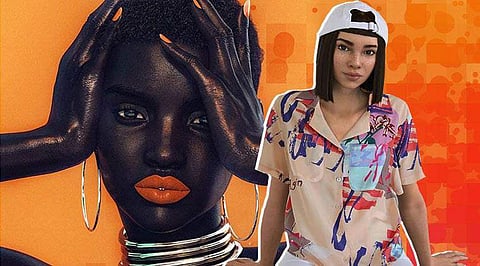

"People think modelling’s mindless, that you just stand there and pose, but it doesn’t have to be that way. I like to have a lot of input. I know how to wear a dress, whether it should be shot with me standing or sitting" — Linda Evangelista, Canadian model
Now, the likes of Linda can rest in peace, because there is a possibility of models being phased out and replaced by digital supermodels. But first, the facts as reported.
Carrying three authentic-looking models as visual, the report said: “The three women gazing into the camera in an advert for French luxury label Balmain look like they could fit in at any high-end shoot, but Shudu, Margot and Zhi are ‘digital models’ whose rise is dividing the fashion world.” It went on to report that the computer-generated trio at the centre of Balmain’s new campaign is the latest example of fashion brands embracing technology to lure digital-savvy younger clients.
The best known of the three is Shudu, a black digital model created by visual artist Cameron-James Wilson last year. She has her own Instagram account with 145,000 followers which describes her as ‘the world’s first digital supermodel’. Modelling shots include her wearing Tiffany jewellery for Vogue Australia.
Responses from the industry during New York and London fashion weeks were mixed, with designer Michael Kors among those critical of computer-generated imagery (CGI) being used in this way. “I am not into a digital model. I am into real people with personalities and opinions,” Kors said.
But British designer Alice Temperley believes using CGI could help cut costs. “I quite like the idea of doing some of that for the commercial and then, spending the money on doing events,” Temperley said at London Fashion Week. Shudu’s creator said the rise of CGI in fashion was inevitable. “After all, we see CGI being used in almost every other industry,” Wilson said in an email statement, “3D and fashion were two worlds destined to collide.”
It may be relevant to recall another development in the fashion modelling industry that shows changes have been taking place over the last several decades. It started with Twiggy.
Lesley Lawson (b 1949) is an English model, actress, and singer widely known by the nickname Twiggy. She was a British cultural icon and a prominent teenage model in swinging sixties London. She was initially known for her thin build and her androgynous look consisting of big eyes, long eyelashes and short hair. In 1966, she was named ‘The Face of 1966’ by the Daily Express and voted British Woman of the Year. By 1967, she had modelled in France, Japan, and the US, and had landed on the covers of Vogue and The Tatler. Her fame had spread worldwide.
Then many models tried to imitate her and thin was in in the modelling world. But over the last two decades, there was a reaction to this and thin was out with many venues prohibiting anorexic models from strutting down the runway — applying new standards of minimum weight in relation to the height of model with reference to the Body Mass Index.
Now comes the bolt from the blue for models in flesh and blood — opening so many unwelcome possibilities including gradual phasing out of live models.
